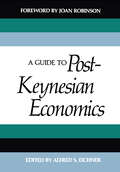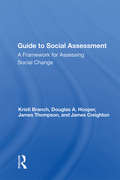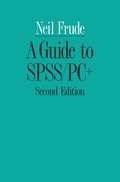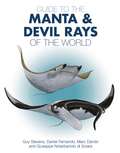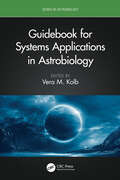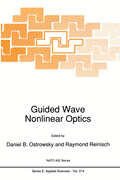- Table View
- List View
A Guide to Numerical Modelling in Systems Biology (Texts in Computational Science and Engineering #12)
by Peter Deuflhard Susanna RöblitzThis book is intended for students of computational systems biology with only a limited background in mathematics. Typical books on systems biology merely mention algorithmic approaches, but without offering a deeper understanding. On the other hand, mathematical books are typically unreadable for computational biologists. The authors of the present book have worked hard to fill this gap. The result is not a book on systems biology, but on computational methods in systems biology. This book originated from courses taught by the authors at Freie Universität Berlin. The guiding idea of the courses was to convey those mathematical insights that are indispensable for systems biology, teaching the necessary mathematical prerequisites by means of many illustrative examples and without any theorems. The three chapters cover the mathematical modelling of biochemical and physiological processes, numerical simulation of the dynamics of biological networks and identification of model parameters by means of comparisons with real data. Throughout the text, the strengths and weaknesses of numerical algorithms with respect to various systems biological issues are discussed. Web addresses for downloading the corresponding software are also included.
A Guide to Physics Problems: Part 2: Thermodynamics, Statistical Physics, and Quantum Mechanics
by Sidney B. Cahn Gerald D. Mahan Boris E. NadgornyIn order to equip hopeful graduate students with the knowledge necessary to pass the qualifying examination, the authors have assembled and solved standard and original problems from major American universities – Boston University, University of Chicago, University of Colorado at Boulder, Columbia, University of Maryland, University of Michigan, Michigan State, Michigan Tech, MIT, Princeton, Rutgers, Stanford, Stony Brook, University of Tennessee at Knoxville, and the University of Wisconsin at Madison – and Moscow Institute of Physics and Technology. A wide range of material is covered and comparisons are made between similar problems of different schools to provide the student with enough information to feel comfortable and confident at the exam. Guide to Physics Problems is published in two volumes: this book, Part 2, covers Thermodynamics, Statistical Mechanics and Quantum Mechanics; Part 1, covers Mechanics, Relativity and Electrodynamics. Praise for A Guide to Physics Problems: Part 2: Thermodynamics, Statistical Physics, and Quantum Mechanics: "… A Guide to Physics Problems, Part 2 not only serves an important function, but is a pleasure to read. By selecting problems from different universities and even different scientific cultures, the authors have effectively avoided a one-sided approach to physics. All the problems are good, some are very interesting, some positively intriguing, a few are crazy; but all of them stimulate the reader to think about physics, not merely to train you to pass an exam. I personally received considerable pleasure in working the problems, and I would guess that anyone who wants to be a professional physicist would experience similar enjoyment. … This book will be a great help to students and professors, as well as a source of pleasure and enjoyment." (From Foreword by Max Dresden) "An excellent resource for graduate students in physics and, one expects, also for their teachers." (Daniel Kleppner, Lester Wolfe Professor of Physics Emeritus, MIT) "A nice selection of problems … Thought-provoking, entertaining, and just plain fun to solve." (Giovanni Vignale, Department of Physics and Astronomy, University of Missouri at Columbia) "Interesting indeed and enjoyable. The problems are ingenious and their solutions very informative. I would certainly recommend it to all graduate students and physicists in general … Particularly useful for teachers who would like to think about problems to present in their course." (Joel Lebowitz, Rutgers University) "A very thoroughly assembled, interesting set of problems that covers the key areas of physics addressed by Ph.D. qualifying exams. … Will prove most useful to both faculty and students. Indeed, I plan to use this material as a source of examples and illustrations that will be worked into my lectures." (Douglas Mills, University of California at Irvine)
A Guide to Physics Problems: Part 1: Mechanics, Relativity, and Electrodynamics
by Sidney B. Cahn Boris E. NadgornyIn order to equip hopeful graduate students with the knowledge necessary to pass the qualifying examination, the authors have assembled and solved standard and original problems from major American universities – Boston University, University of Chicago, University of Colorado at Boulder, Columbia, University of Maryland, University of Michigan, Michigan State, Michigan Tech, MIT, Princeton, Rutgers, Stanford, Stony Brook, University of Wisconsin at Madison – and Moscow Institute of Physics and Technology. A wide range of material is covered and comparisons are made between similar problems of different schools to provide the student with enough information to feel comfortable and confident at the exam. Guide to Physics Problems is published in two volumes: this book, Part 1, covers Mechanics, Relativity and Electrodynamics; Part 2 covers Thermodynamics, Statistical Mechanics and Quantum Mechanics. Praise for A Guide to Physics Problems: Part 1: Mechanics, Relativity, and Electrodynamics: "Sidney Cahn and Boris Nadgorny have energetically collected and presented solutions to about 140 problems from the exams at many universities in the United States and one university in Russia, the Moscow Institute of Physics and Technology. Some of the problems are quite easy, others are quite tough; some are routine, others ingenious." (From the Foreword by C. N. Yang, Nobelist in Physics, 1957) "Generations of graduate students will be grateful for its existence as they prepare for this major hurdle in their careers." (R. Shankar, Yale University) "The publication of the volume should be of great help to future candidates who must pass this type of exam." (J. Robert Schrieffer, Nobelist in Physics, 1972) "I was positively impressed … The book will be useful to students who are studying for their examinations and to faculty who are searching for appropriate problems." (M. L. Cohen, University of California at Berkeley) "If a student understands how to solve these problems, they have gone a long way toward mastering the subject matter." (Martin Olsson, University of Wisconsin at Madison) "This book will become a necessary study guide for graduate students while they prepare for their Ph.D. examination. It will become equally useful for the faculty who write the questions." (G. D. Mahan, University of Tennessee at Knoxville)
A Guide to Planning and Managing Open Innovative Ecosystems
by João Leitão, Vanessa Ratten, Jean BarrocaDigital technology in the form of big data and data analytics is transforming the global economy. This book is the first to take an open innovation perspective to the study and practice of ecosystems, providing a novel way of understanding the impact data has on the way entrepreneurial firms develop. Governments are emphasising the use of open innovation ecosystems due to increased levels of digitalization in the global economy. This enables information and knowledge to be disseminated in a way that enables entrepreneurial projects to develop. Written primarily for practitioners and academic researchers, A Guide to Planning and Managing Open Innovative Ecosystems focuses on the unique nature of open innovation by utilising a government and data perspective. This helps to understand the dynamic manner in which digital technology in the form of big data is changing society. The role of the government in influencing an open innovation culture in society is discussed through the use of different cultural examples, enabling a holistic perspective about how government and data are influencing entrepreneurial endeavours.
A Guide to Planning and Managing Open Innovative Ecosystems
by João Leitão Vanessa Ratten Jean BarrocaDigital technology in the form of big data and data analytics is transforming the global economy. This book is the first to take an open innovation perspective to the study and practice of ecosystems, providing a novel way of understanding the impact data has on the way entrepreneurial firms develop. Governments are emphasising the use of open innovation ecosystems due to increased levels of digitalization in the global economy. This enables information and knowledge to be disseminated in a way that enables entrepreneurial projects to develop. Written primarily for practitioners and academic researchers, A Guide to Planning and Managing Open Innovative Ecosystems focuses on the unique nature of open innovation by utilising a government and data perspective. This helps to understand the dynamic manner in which digital technology in the form of big data is changing society. The role of the government in influencing an open innovation culture in society is discussed through the use of different cultural examples, enabling a holistic perspective about how government and data are influencing entrepreneurial endeavours.
A Guide to Post-Keynesian Economics
by Alfred S. EichnerDoes there exist an alternative to the “neoclassical synthesis” presented to students in introductory, intermediate, and advanced economics courses? The alternative is the post-Keynesian theory which is the subject of this book.
A Guide to Post-Keynesian Economics
Does there exist an alternative to the “neoclassical synthesis” presented to students in introductory, intermediate, and advanced economics courses? The alternative is the post-Keynesian theory which is the subject of this book.
Guide to Process Based Modeling of Lakes and Coastal Seas (Springer Praxis Books)
by Anders OmstedtThis new edition of Guide to Process Based Modeling of Lakes and Coastal Seas brings the modeling up to date, taking into account multiple stressors acting on aquatic systems. The combination of acidification and increasing amounts of anoxic waters associated with eutrophication puts severe stress on the marine environment. The detection and attribution of anthropogenic changes in coastal seas are therefore crucial and transparent modeling tools are increasingly important. Modeling the marine CO2–O2 system makes systematic studies on climate change and eutrophication possible and is fundamental for understanding the Earth system. This second edition also includes new sections on detection and attribution and on modeling future changes, as well as improved exercises, updated software, and datasets.This unique book will stimulate students and researchers to develop their modeling skills and make model codes and data transparent to other research groups. It uses the general equation solver PROBE to introduce process-oriented numerical modeling and to build understanding of the subject step by step. The equation solver has been used in many applications, particularly in Sweden and Finland with their numerous lakes, archipelago seas, fjords, and coastal zones. It has also been used for process studies in the Polar Seas and the Mediterranean Sea and the approach is suitable for applications in many other environmental applications.Guide to Process Based Modeling of Lakes and Coastal Seas:• is a unique teaching tool for systematic learning of aquatic modeling;• approaches lake and ocean modeling from a new angle;• introduces aquatic numerical modeling using a process-based approach;• enables the thorough understanding of the physics and biogeochemistryof lakes and coastal seas;• provides software, datasets, and algorithms needed to reproduce allcalculations and results in the book;• provides a number of creative and stimulating exercises with solutions;• addresses the interaction between climate change and eutrophicationand is a good basis for learning Earth System Sciences.
Guide to Process Based Modeling of Lakes and Coastal Seas (Springer Praxis Books)
by Anders OmstedtMounting concern about the influence of humans on climate and environmental conditions has increased the need for multi-disciplinary modeling efforts, including systems such as oceans, costal seas, lakes, land surfaces, ice, rivers and atmosphere. This unique book will stimulate students and researchers to developtheir modeling skills and make model codes and data transparentto other research groups. The book uses the general equation solverPROBE to introduce process oriented numerical modeling and tobuild understanding of the subject step by step. PROBE is a generalequation solver for one-dimensional transient, or two-dimensionalsteady, boundary layers. By the construction of nets of sub-basins thebook illustrates how the process based modeling can be extended,complementing three-dimensional modeling. The equation solver hasbeen used in many applications, particularly in Sweden and Finlandwith their numerous lakes, archipelago seas, fjords, and coastal zones.It has also been used for process studies in the Arctic and in theMediterranean Sea and the approach is general for applications in manyother environmental applications.... more on http://springer.com/978-3-642-17727-9.
A Guide to Scholarly Resources on the Russian Empire and the Soviet Union in the New York Metropolitan Area
by Robert A. KarlowichIdentifies collections held by public and university libraries, historical societies, and other institutions, as well as private collections, with material relating to any subject and historical period, and to the widest geographical area under imperial or Soviet rule. Includes movements for example
A Guide to Scholarly Resources on the Russian Empire and the Soviet Union in the New York Metropolitan Area
by Robert A. KarlowichIdentifies collections held by public and university libraries, historical societies, and other institutions, as well as private collections, with material relating to any subject and historical period, and to the widest geographical area under imperial or Soviet rule. Includes movements for example
Guide To Social Impact Assessment: A Framework For Assessing Social Change
by Kristi BranchDesigned to provide clear and detailed assistance in the complex process of assessing social change, this book emphasizes the development of an analytic approach and a theoretical framework that can be applied to the assessment of very diverse events--changes in the natural environment, the local economy, or the dominant technology. The guide, based on a sociological perspective that highlights the importance of community social organization in analyzing social change, focuses on the development of user skills in assessment design, research, analysis, and presentation. The guide's theoretical basis and emphasis on the interrelationships that create social change make it valuable to those studying social change in general, as well as to those responsible for conducting or utilizing social impact assessments. Detailed "how to" information, clear writing, and careful design impart the skills necessary to identify and analyze the factors and processes leading to social change and to interpret and present research findings in an effective manner.
Guide To Social Impact Assessment: A Framework For Assessing Social Change
by Kristi BranchDesigned to provide clear and detailed assistance in the complex process of assessing social change, this book emphasizes the development of an analytic approach and a theoretical framework that can be applied to the assessment of very diverse events--changes in the natural environment, the local economy, or the dominant technology. The guide, based on a sociological perspective that highlights the importance of community social organization in analyzing social change, focuses on the development of user skills in assessment design, research, analysis, and presentation. The guide's theoretical basis and emphasis on the interrelationships that create social change make it valuable to those studying social change in general, as well as to those responsible for conducting or utilizing social impact assessments. Detailed "how to" information, clear writing, and careful design impart the skills necessary to identify and analyze the factors and processes leading to social change and to interpret and present research findings in an effective manner.
A Guide to Spectral Theory: Applications and Exercises (Birkhäuser Advanced Texts Basler Lehrbücher)
by Christophe Cheverry Nicolas RaymondThis textbook provides a graduate-level introduction to the spectral theory of linear operators on Banach and Hilbert spaces, guiding readers through key components of spectral theory and its applications in quantum physics. Based on their extensive teaching experience, the authors present topics in a progressive manner so that each chapter builds on the ones preceding. Researchers and students alike will also appreciate the exploration of more advanced applications and research perspectives presented near the end of the book.Beginning with a brief introduction to the relationship between spectral theory and quantum physics, the authors go on to explore unbounded operators, analyzing closed, adjoint, and self-adjoint operators. Next, the spectrum of a closed operator is defined and the fundamental properties of Fredholm operators are introduced. The authors then develop the Grushin method to execute the spectral analysis of compact operators. The chapters that follow are devoted to examining Hille-Yoshida and Stone theorems, the spectral analysis of self-adjoint operators, and trace-class and Hilbert-Schmidt operators. The final chapter opens the discussion to several selected applications. Throughout this textbook, detailed proofs are given, and the statements are illustrated by a number of well-chosen examples. At the end, an appendix about foundational functional analysis theorems is provided to help the uninitiated reader.A Guide to Spectral Theory: Applications and Exercises is intended for graduate students taking an introductory course in spectral theory or operator theory. A background in linear functional analysis and partial differential equations is assumed; basic knowledge of bounded linear operators is useful but not required. PhD students and researchers will also find this volume to be of interest, particularly the research directions provided in later chapters.
A Guide to SPSS/PC+
by Neil FrudeWritten for those with little or no experience in using computers for statistical analysis, this book introduces SPSS/PC+, the market leader PC package. A Guide to SPSS/PC+ teaches the use of SPSS/PC+ clearly and simply. Following the book, which is organized as a progressive tutorial, readers can analyze their own data, or may follow worked examples using the complete dataset which is included. The appendices provide a comprehensive guide for beginners and for those needing to revise their SPSS/PC+ skills. A Guide to SPSS/PC+ is now in its second edition and has been revised to cover the new developments available within Version 4.0 of SPSS/PC.
A Guide to Sustainable Corporate Responsibility: From Theory to Action
by Caroline D. Ditlev-SimonsenThis open access book discusses the challenges and opportunities faced by companies in an age that increasingly values sustainability and demands corporate responsibility. Beginning with the historical development of corporate responsibility, this book moves from academic theory to practical application. It points to ways in which companies can successfully manage their transition to a more responsible, sustainable way of doing business, common mistakes to avoid and how the UN Sustainable Development Goals are integral to any sustainability transformation. Practical cases illustrate key points. Drawing on thirty years of sustainability research and extensive corporate experience, the author provides tools such as a Step-by-Step strategic guide on integrating sustainability in collaboration with stakeholders including employees, customers, suppliers and investors. The book is particularly relevant for SMEs and companies operating in emerging markets. From a broader perspective, the value of externalities, full cost pricing, alternative economic theories and circular economy are also addressed.
The Guide to the Circular Economy: Capturing Value and Managing Material Risk
by Dustin Benton Jonny Hazell Julie HillThe term "Circular Economy" is becoming familiar to an increasing number of businesses. It expresses an aspiration to get more value from resources and waste less, especially as resources come under a variety of pressures – price-driven, political and environmental.Delivering the circular economy can bring direct costs savings to businesses, reduce risk and offer reputational advantages, and can therefore be a market differentiator – but working out what counts as "circular" activity for an individual business, as against the entire economy or individual products, is not straightforward.This guide to the circular economy gives examples of what this new business model looks like in practice, and showcases businesses opportunities around circular activity. It also: explores the debate around circular economy metrics and indicators and helps you assess your current level of circularity, set priorities and measure success; equips readers to make the links between their own company’s initiatives and those of others, making those activities count by influencing actors across the supply chain; outlines the conditions that have enabled other companies to change the system in which they operate. Finally, this expert short work sets the circular economy in a political and business context, so you understand where it has come from and where it is going.
The Guide to the Circular Economy: Capturing Value and Managing Material Risk (Doshorts Ser.)
by Dustin Benton Jonny Hazell Julie HillThe term "Circular Economy" is becoming familiar to an increasing number of businesses. It expresses an aspiration to get more value from resources and waste less, especially as resources come under a variety of pressures – price-driven, political and environmental.Delivering the circular economy can bring direct costs savings to businesses, reduce risk and offer reputational advantages, and can therefore be a market differentiator – but working out what counts as "circular" activity for an individual business, as against the entire economy or individual products, is not straightforward.This guide to the circular economy gives examples of what this new business model looks like in practice, and showcases businesses opportunities around circular activity. It also: explores the debate around circular economy metrics and indicators and helps you assess your current level of circularity, set priorities and measure success; equips readers to make the links between their own company’s initiatives and those of others, making those activities count by influencing actors across the supply chain; outlines the conditions that have enabled other companies to change the system in which they operate. Finally, this expert short work sets the circular economy in a political and business context, so you understand where it has come from and where it is going.
Guide to the Manta and Devil Rays of the World (Wild Nature Press)
by Dr. Guy Stevens Dr. Daniel Fernando Marc Dando Dr. Giuseppe Notarbartolo Di SciaraManta and devil rays are some of the most intriguing creatures in the ocean. Driven forward by powerful beats of wing-like pectoral fins, these filter feeders search the waters for prey, their horn-like head fins giving rise to ancient mariners’ tales of fearsome devilfish dragging boats into the ocean depths. Beloved by scuba divers and marine biologists alike, these impressive animals have never had a comprehensive field guide dedicated to them—until now.Guide to the Manta and Devil Rays of the World includes detailed information on the identification, characteristics, threats, and distribution for each species in this family. Illustrated with more than 200 color photos, drawings, and plates, this guide also contains an expansive introduction to the general taxonomy, biology, and behavior of these iconic animals. This book will be an essential resource for fisheries management and international trade enforcement, and for anyone involved in ongoing manta and devil ray research and conservation. The first dedicated field guide for manta and devil raysExhaustive treatment of every aspect related to their identification and biologyFilled with 200+ color drawings, photos, and diagrams
A Guide to the Systems of Provision Approach: Who Gets What, How and Why
by Kate Bayliss Ben FineUnderstanding consumption requires looking at the systems by which goods and services are provided – not just how they are produced but the historically evolved structures, power relations and cultures within which they are located. The Systems of Provision approach provides an interdisciplinary framework for unpacking these complex issues. This book provides a comprehensive account of the Systems of Provision approach, setting out core concepts and theoretical origins alongside numerous case studies. The book combines fresh understandings of everyday consumption using examples from food, housing, and water, with implications for society’s major challenges, including inequality, climate change, and prospects for capitalism. Readers do not require prior knowledge across the subject matter covered but the text remains significant for accomplished researchers and policymakers, especially those interested in the messy real world realities underpinning who gets what, how, and why across public and private provision in global, national, and historical contexts.
A Guide To U.S. Aircraft Noise Regulatory Policy (Springerbriefs In Applied Sciences And Technology Ser.)
by Sanford Fidell Vincent MestreAviation noise remains the primary hindrance to expansion of airport and airspace capacity in the United States. This book describes the development and practice of U.S. aircraft noise regulation, as well as the practical consequences of regulatory policy. Starting in the pre-jet transport era, the book traces the development of the modern framework for characterizing, standardizing, predicting, disclosing, and mitigating aircraft noise and its effects on airport-vicinity communities. Among other matters, the book treats noise-related consequences of the 1978 deregulation of the airline industry; prediction and mitigation of community reaction to airport noise; land use compatibility planning; recent research and industry trends; and some suggestions for potential improvements to current policy. Initial chapters describe the assumptions underlying aircraft noise regulation, and lay out the chronology of U.S. aircraft noise regulatory practice. Later chapters provide overviews of population-level effects of aviation noise, including health effects, speech and sleep interference, and annoyance. Readers will learn why predictions of the prevalence of aircraft noise-induced annoyance have systematically underestimated adverse community response to aircraft noise, and how such underestimation has complicated approval and funding of airport and airspace improvement projects. They will also learn why attempts at noise-compatible land use planning are seldom fully successful.
A Guidebook for Riverside Regeneration: Artery - Transforming Riversides for the Future
by Frank Bothmann Rudolf Kerndlmaier Albert I. Koffeman Klaus Mandel Sarah Wallbank"Artery" is an initiative on a European scale, funded by the INTERREG IIIB NWE programme, which puts riverside restoration and regeneration at the heart of regional strategies, helping communities across Europe ‘turn back to face the water’. This book discusses the implemented strategies of the Artery initiative, including public-private-partnership, public participation, awareness programs and regional development strategies.
Guidebook for Systems Applications in Astrobiology (Series in Astrobiology)
by Vera M. KolbThis book addresses the timely subject of systems applications in astrobiology. It demonstrates how astrobiology – a multidisciplinary, interdisciplinary, and transdisciplinary field of science – can benefit from adopting the systems approach. Astrobiology draws upon its founding sciences, such as astronomy, physics, chemistry, biochemistry, geology, and planetary sciences. However, astrobiologists can encounter difficulties working across these fields. The systems approach, we believe, is the best contemporary approach to consider astrobiology holistically. The approach is currently used in other fields, such as engineering, which uses systems analysis routinely. Such an approach needs to be learned, both in principle and through examples, from the field. This book features chapters from experts across the field of astrobiology who have applied the systems approach. It will be a valuable guide for astrobiology students at the advanced undergraduate and graduate levels, in addition to researchers in the field, both in academia and the space industry. Key Features: Offers a unique and novel approach to studying and understanding astrobiology Encourages astrobiologists to apply a holistic systems approach to their work, rather than being bogged down in details Imparts practical knowledge to readers which can be adopted in different research and job opportunities in the field of astrobiology Vera M. Kolb obtained degrees in chemical engineering and organic chemistry from Belgrade University, Serbia, and earned her PhD in organic chemistry from Southern Illinois University, Carbondale, Illinois, United States. Following a 30-year career, she is Professor Emerita of Chemistry at the University of Wisconsin-Parkside, Kenosha, Wisconsin. During her first sabbatical leave with the NASA Specialized Center of Research and Training (NSCORT) in Astrobiology, she conducted research with Dr. Leslie Orgel at the Salk Institute and Prof. Stanley Miller at UC San Diego. Her second sabbatical was with Prof. Joseph Lambert at Northwestern University, where she studied sugar silicates and their potential astrobiological relevance. She is credited for authoring over 160 publications, in the fields of organic and medicinal chemistry, green chemistry, and astrobiology, including several books. Recently, she authored Green Organic Chemistry and Its Interdisciplinary Applications (CRC 2016). In the astrobiology field, she edited Astrobiology: An Evolutionary Approach (CRC 2015) and Handbook of Astrobiology (CRC 2019). She co-authored (with Benton C. Clark) Astrobiology for a General Reader: A Questions and Answers Approach (CSP 2020) and Systems Approach to Astrobiology (CRC 2023).
Guidebook for Systems Applications in Astrobiology (Series in Astrobiology)
This book addresses the timely subject of systems applications in astrobiology. It demonstrates how astrobiology – a multidisciplinary, interdisciplinary, and transdisciplinary field of science – can benefit from adopting the systems approach. Astrobiology draws upon its founding sciences, such as astronomy, physics, chemistry, biochemistry, geology, and planetary sciences. However, astrobiologists can encounter difficulties working across these fields. The systems approach, we believe, is the best contemporary approach to consider astrobiology holistically. The approach is currently used in other fields, such as engineering, which uses systems analysis routinely. Such an approach needs to be learned, both in principle and through examples, from the field. This book features chapters from experts across the field of astrobiology who have applied the systems approach. It will be a valuable guide for astrobiology students at the advanced undergraduate and graduate levels, in addition to researchers in the field, both in academia and the space industry. Key Features: Offers a unique and novel approach to studying and understanding astrobiology Encourages astrobiologists to apply a holistic systems approach to their work, rather than being bogged down in details Imparts practical knowledge to readers which can be adopted in different research and job opportunities in the field of astrobiology Vera M. Kolb obtained degrees in chemical engineering and organic chemistry from Belgrade University, Serbia, and earned her PhD in organic chemistry from Southern Illinois University, Carbondale, Illinois, United States. Following a 30-year career, she is Professor Emerita of Chemistry at the University of Wisconsin-Parkside, Kenosha, Wisconsin. During her first sabbatical leave with the NASA Specialized Center of Research and Training (NSCORT) in Astrobiology, she conducted research with Dr. Leslie Orgel at the Salk Institute and Prof. Stanley Miller at UC San Diego. Her second sabbatical was with Prof. Joseph Lambert at Northwestern University, where she studied sugar silicates and their potential astrobiological relevance. She is credited for authoring over 160 publications, in the fields of organic and medicinal chemistry, green chemistry, and astrobiology, including several books. Recently, she authored Green Organic Chemistry and Its Interdisciplinary Applications (CRC 2016). In the astrobiology field, she edited Astrobiology: An Evolutionary Approach (CRC 2015) and Handbook of Astrobiology (CRC 2019). She co-authored (with Benton C. Clark) Astrobiology for a General Reader: A Questions and Answers Approach (CSP 2020) and Systems Approach to Astrobiology (CRC 2023).
Guided Wave Nonlinear Optics (NATO Science Series E: #214)
by D. B. Ostrowsky R. ReinischThe object of this school, held at Cargese, Corsica (France) from August 12th to 24th 1991, was the presentation of the field of guided wave nonlinear optics in a comprehensive, coherent, and heuristic fashion. It seems appropriate that this school began with an historical introduction by Professor Nicolaas Bloembergen of Harvard, the acknowledged "father" of nonlinear optics, in general, and concluded with a round table discussion headed by Dr. Eric Spitz, the Scientific Director of a multinational electronics company interested in developing industrial applications of guided wave nonlinear optics. The lectures covered both the theoretical framework of the field and applications to basic scientific research, optical communications and technical instrumentation. Specific topics developed included materials for guided wave nonlinear optics, nonlinear interactions using integrated optical guides, nonlinear surface waves, solitons, fiber nonlinear optics, ultra-fast coupler switching as well as the related topic of fiber and integrated optical lasers and amplifiers. Lectures have also been devoted to squeezed states, chaos and strange attractors. The subjects covered by the school underlines one of the major ways in which this field has evolved over the past thirty some odd years. The path from the original experiments with materials requiring mega-watt power lasers to the recent developments in guided wave configurations using milliwatt power diode lasers is marked by the conjunction of ever improving fundamental scientific comprehension and continuing technological developments.




